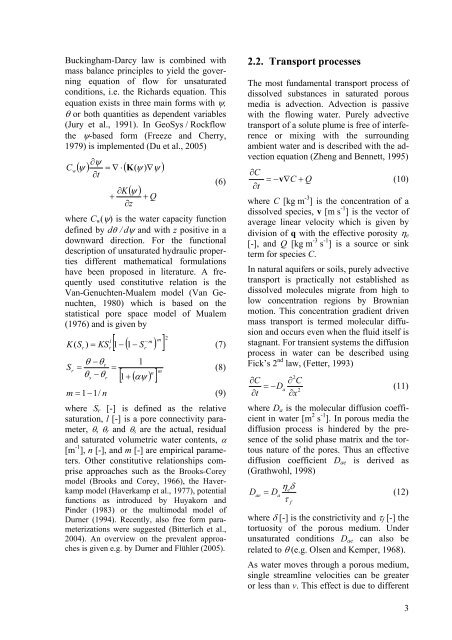Applied numerical modeling of saturated / unsaturated flow and ...
Applied numerical modeling of saturated / unsaturated flow and ...
Applied numerical modeling of saturated / unsaturated flow and ...
You also want an ePaper? Increase the reach of your titles
YUMPU automatically turns print PDFs into web optimized ePapers that Google loves.
Buckingham-Darcy law is combined with<br />
mass balance principles to yield the governing<br />
equation <strong>of</strong> <strong>flow</strong> for un<strong>saturated</strong><br />
conditions, i.e. the Richards equation. This<br />
equation exists in three main forms with �,<br />
� or both quantities as dependent variables<br />
(Jury et al., 1991). In GeoSys / Rock<strong>flow</strong><br />
the �-based form (Freeze <strong>and</strong> Cherry,<br />
1979) is implemented (Du et al., 2005)<br />
C w<br />
��<br />
�t<br />
��� � � � �K ( � ) ��<br />
�<br />
�K<br />
�<br />
�z<br />
��� � Q<br />
(6)<br />
where Cw(�) is the water capacity function<br />
defined by d� /d� <strong>and</strong> with z positive in a<br />
downward direction. For the functional<br />
description <strong>of</strong> un<strong>saturated</strong> hydraulic properties<br />
different mathematical formulations<br />
have been proposed in literature. A frequently<br />
used constitutive relation is the<br />
Van-Genuchten-Mualem model (Van Genuchten,<br />
1980) which is based on the<br />
statistical pore space model <strong>of</strong> Mualem<br />
(1976) <strong>and</strong> is given by<br />
� � � �2 �m<br />
m<br />
1�<br />
1�<br />
Sr<br />
l<br />
K(<br />
S ) � KS<br />
(7)<br />
Sr<br />
r<br />
� ��<br />
r � �<br />
� ��<br />
s<br />
r<br />
r<br />
1<br />
� � � �m n<br />
1�<br />
��<br />
(8)<br />
m � 1� 1/<br />
n<br />
(9)<br />
where Sr [-] is defined as the relative<br />
saturation, l [-] is a pore connectivity parameter,<br />
�, �r <strong>and</strong> �s are the actual, residual<br />
<strong>and</strong> <strong>saturated</strong> volumetric water contents, �<br />
[m -1 ], n [-], <strong>and</strong> m [-] are empirical parameters.<br />
Other constitutive relationships comprise<br />
approaches such as the Brooks-Corey<br />
model (Brooks <strong>and</strong> Corey, 1966), the Haverkamp<br />
model (Haverkamp et al., 1977), potential<br />
functions as introduced by Huyakorn <strong>and</strong><br />
Pinder (1983) or the multimodal model <strong>of</strong><br />
Durner (1994). Recently, also free form parameterizations<br />
were suggested (Bitterlich et al.,<br />
2004). An overview on the prevalent approaches<br />
is given e.g. by Durner <strong>and</strong> Flühler (2005).<br />
2.2. Transport processes<br />
The most fundamental transport process <strong>of</strong><br />
dissolved substances in <strong>saturated</strong> porous<br />
media is advection. Advection is passive<br />
with the <strong>flow</strong>ing water. Purely advective<br />
transport <strong>of</strong> a solute plume is free <strong>of</strong> interference<br />
or mixing with the surrounding<br />
ambient water <strong>and</strong> is described with the advection<br />
equation (Zheng <strong>and</strong> Bennett, 1995)<br />
�C<br />
�t<br />
� �v<br />
�C<br />
� Q<br />
(10)<br />
where C [kg m -3 ] is the concentration <strong>of</strong> a<br />
dissolved species, v [m s -1 ] is the vector <strong>of</strong><br />
average linear velocity which is given by<br />
division <strong>of</strong> q with the effective porosity �e<br />
[-], <strong>and</strong> Q [kg m -3 s -1 ] is a source or sink<br />
term for species C.<br />
In natural aquifers or soils, purely advective<br />
transport is practically not established as<br />
dissolved molecules migrate from high to<br />
low concentration regions by Brownian<br />
motion. This concentration gradient driven<br />
mass transport is termed molecular diffusion<br />
<strong>and</strong> occurs even when the fluid itself is<br />
stagnant. For transient systems the diffusion<br />
process in water can be described using<br />
Fick’s 2 nd law, (Fetter, 1993)<br />
2<br />
�C<br />
� C<br />
� �Da<br />
2<br />
�t<br />
�x<br />
(11)<br />
where Da is the molecular diffusion coefficient<br />
in water [m 2 s -1 ]. In porous media the<br />
diffusion process is hindered by the presence<br />
<strong>of</strong> the solid phase matrix <strong>and</strong> the tortous<br />
nature <strong>of</strong> the pores. Thus an effective<br />
diffusion coefficient Dae is derived as<br />
(Grathwohl, 1998)<br />
D<br />
� �<br />
e<br />
ae a<br />
f<br />
D � (12)<br />
�<br />
where � [-] is the constrictivity <strong>and</strong> �f [-] the<br />
tortuosity <strong>of</strong> the porous medium. Under<br />
un<strong>saturated</strong> conditions Dae can also be<br />
related to � (e.g. Olsen <strong>and</strong> Kemper, 1968).<br />
As water moves through a porous medium,<br />
single streamline velocities can be greater<br />
or less than v. This effect is due to different<br />
3

















